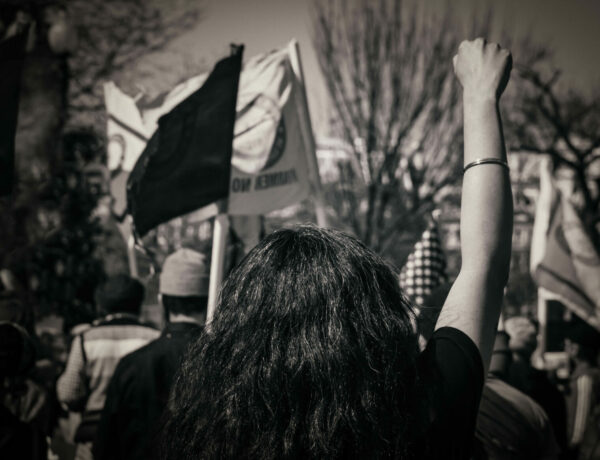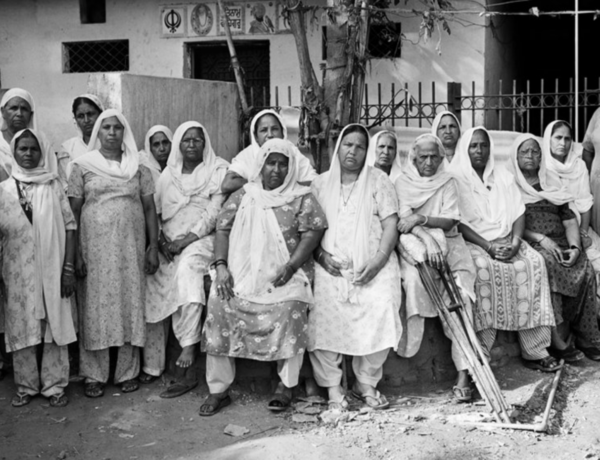Feature photo: Punjabi Suba protestors at Darbar Sahib Amritsar via Punjab Digital Library.
by Lakhpreet Kaur
Introduction
In early June of 1984, the Indian Army invaded Harmandir Sahib under the orders of Indian Prime Minister Indira Gandhi to “flush out Sikh terrorists”; the official name was “Operation Blue Star“. During the invasion, the army killed thousands of Sikh civilians. Then on October 31, 1984, after the assassination of Indira Gandhi, the Indian Government orchestrated anti-Sikh pogroms across India which lead to the murder of thousands more.
In the Sikh Panth, these attacks are colloquially referred to as “1984” and have shaped the collective Sikh psyche.
This series of three articles hopes to serve as a brief introduction to the events of 1984 and to provide a starting point for those interested in learning about the historical events. So the information is accessible to everyone, we will not be sharing graphic descriptions or triggering details. Rather, we will share with you resources where you can read eye witness accounts, if you are interested.
Before we start, we would like to take this opportunity to honor the Singhs and Kaurs affected by the violence of 1984, and the shaheeds who laid down their lives defending the Panth.
Part 1: The Anti-Sikh Violence of 1984 | The Background
Part 2: The Anti-Sikh Violence of 1984 | The Battle of Amritsar (aka Operation Bluestar)
Part 3: The Anti-Sikh Violence of 1984 | Anti-Sikh Pogroms
Part 1: The Background
Background: Leading Up to the Attacks
The attacks of 1984 cannot be understood in isolation. They are the result of historical memory, rising activism in Punjab, and decades of tensions between Sikh Punjabis and the Central Indian Government.
The Sikh Gurus sought to establish the Sikh Panth outside of mainstream society and used the Panth to challenge corrupt political and religious dominance, (Singh, J., 1981). As such, Sikhs have been a frequent target of state violence since the 1400s.
1469 to 1930s – The Gurus & Sikh Raj
Due to historical precedence and the concept of Miri-Piri, many Sikhs feel that autonomy and self-determination is inherent within Sikhi and the land of Punjab. From the Gurus establishing cities , the Manji (an administrative system headed by Sikh men and women) and Pirhi Systems (a missionary system run by Sikh women), to Banda Singh Bahadur establishing a Sikh state, to maharajas and maharanis ruling over Punjab, the notion of a Sikh sovereignty is deep within our collective conscious which in part, contextualizes the events of 1984.
1930s to 1950s – Independence from the British
Starting in the 1930s, the Sikh desire for a (re-claimed) homeland was used as a political tool by those in power, primarily the British, to destabilize the Indian independence movement. Leading up to the British leaving India, Sikh masses wanted a sovereign nation-state. But, as the date for the division of the Punjab approached, Sikh leaders were unsure of the best political ally – whether to side with Pakistan or India, (Singh, K., 1999).
Muhammad Ali Jinnah, leader of the All-India Muslim League and former Governor-General of Pakistan, told Sikh leaders that if they sided with Pakistan, he would guarantee Sikhs protection of life, property, freedom of religion, and the privileges they had enjoyed under British rule. On the other hand, leaders of the Indian Congress Party, told leaders that Sikhs should look upon India as their home. Jawaharlal Nehru, Former Prime Minister of India, said, “The brave Sikhs of Punjab are entitled to special consideration. I see nothing wrong in an area and a set up in the North where the Sikhs can also experience the glow of freedom,” (Singh, K., 1999, pg. 291). Emphasizing this, Mohandas Gandhi said, “Sikh friends have no reason to fear that the Congress Party will betray them,” (Singh, K., 1999, pg. 291).
Ultimately, Sikh leadership sided with India’s Congress Party. But, “Post-partition conditions made many Sikhs doubt the wisdom of having thrown in their lot with the Hindus,” (Singh, K., 1999, pg. 292). Broken promises and dissolved alliances left Sikhs without a Sikh-controlled nation-state as Punjab was partitioned in 1947 to create the Muslim majority Pakistan and Hindu majority India.
Sikhs lamented, asking, “The Muslims got their Pakistan, and the Hindus got their Hindustan, but what did the Sikhs get?” To which Nehru responded, “the times have changed” leaving Sikhs nationless after the violence and bloodshed of 1947.
1950s to 1970s – Punjabi Suba Movement
In the 1950s, as India started creating states and administrative districts, Sikhs launched the Punjabi Suba Movement – a movement for the state of Punjab within India, based on the language of Punjabi. Political agitation and civic action peaked in July of 1955 when thousands of Sikhs gathered at Harmandir Sahib to agitate for linguistic and state rights. In response, the Punjab Police increased its presence around Harmindir Sahib. On July 4, 1955, under the orders of Ashwani Kumar, DIG of Jalandhar Police, the police entered the Darbar Sahib complex to suppress the movement. They sealed off exits and entrances, confiscated arms, censored newspapers, arrested journalists, and used firearms and gas on those inside the Harmandir Sahib complex. After four days of occupation, the police ultimately arrested more than 3,000 Sikhs for their involvement in the Punjabi Suba movement
Despite the efforts of the Punjabi Suba Movement, Punjab’s borders were further reduced in the 1950s and 1960s when the Arya Samaj (a monotheistic Indian Hindu movement based on the Vedas) launched a campaign to convince Punjabi-speaking Hindus to disown Punjabi as their mother tongue and select Hindi as their language on censuses. This resulted in the drawing of state borders based on false linguistic lines, and the creation of Haryana and Himachal Pradesh, (Singh, K., 1999). In 1966, through the Punjab Reorganization Act, Punjab was finally declared a state, but it had to share its capital of Chandigarh with Haryana.
The subjugation of Sikhs to police brutality and the subjection of Punjab to a heavily centralized government administration continued beyond redistricting; it spread to the control of Punjabi agricultural markets, heavy industry, canal headworks, and riverwaters, (Kaur, 2004; Singh, K., 1999). Sikhs began to view these actions as government discrimination and started engaging in morchas and peaceful protests, (Singh, K., 1999).
1973 – Anandpur Sahib Resolution
In response to the Indian government’s restriction of Sikh and Punjabi autonomy, the Akali Dal political party drafted the Anandpur Sahib Resolution (ASR) in 1973.
The ASR has some Sikh theological aims (such as the revival of religious practices and institutions) along with political aims (such as re-incorporating Punjabi-speaking areas left out of Punjab, restricting central government powers, implementing agricultural and land policy reform (including the allowance of women’s property inheritance), infrastructure development, labor reform, and establishing riparian rights), (Singh, K., 1999). In 1978, the ASR was endorsed in the form of a succession of resolutions at the 18th All India Akali Conference of the Shiromani Akali Dal at Ludhiana. It was then used as a framework to negotiate rights and guide conversations between Sikh leaders and the Indian Central Government.
1975 – State of Emergency
Tensions between Sikhs and the central government increased with Indira Gandhi’s declaration of a State of Emergency in 1975. This “…allowed her to rule by decree, postpone State and parliamentary elections indefinitely and suspend civil liberties…The Sikhs of Punjab took exception and initiated a campaign against Indira Gandhi’s unlawful rule. ….They protested by the hundreds….In the months that followed over 40,000 Sikhs were imprisoned for their campaign against Indira Gandhi’s National Emergency,” (Kaur, 2004, pg. 16). For their civil disobedience campaign, the Sikhs were vilified by the state owned media, attacked by the police, and oppressed by government policies. “Further complicating the precarious situations, the Sikhs believed their voices were being ignored,” (Kaur, 2004, pg. 16).
The rise of Baba Jarnail Singh Bhindranwale
The next several years were characterized by Sikh and government conflicts. While the government was gaining strength from anti-Sikh supporters, a Sikh religious leader, Baba Jarnail Singh Bindarewale rose to counter their measures. Baba Jarnail Singh launched a grass-roots campaign founded on the ASR: demanding recognition of minority rights and decentralization of power from the Indian government, (Kaur, 2004, pg. 19). He soon developed a large following consisting primarily of rural Punjabi youth who were affected by discriminatory policies. Together, they petitioned for social change through peaceful protests.
Challenged by Baba Jarnail Singh’s rising political power, Indira Gandhi and the Congress Party spread anti-Sikh propaganda and launched smear campaigns. The resulting anti-Sikh and anti-Punjabi sentiment that developed in the larger public was then used to justify state-sponsored oppression. For instance, between 1981 and 1984, over 100,000 Sikhs were arrested while protesting for civil rights, and hundreds of Sikhs were murdered by Indian Security forces in “fake encounters”, a euphemism for extra-judicial executions, (Kaur, 2004). Many of these Sikhs were part of the Dharam Yudh Morcha, an organization unifying different Sikh groups initiated by Baba Jarnail Singh to encourage the peaceful implementation of the ASR.
The Dharam Yudh Morcha was headquartered at Guru Nanak Niwas complex within Harmandir Sahib. Harchand Singh Longowal, President of Shirmoni Akali Dal (a Sikh political party) and dictator of the Dharam Yudh Morcha invited Baba Jarnail Singh to join them and take residence there in the mid-1980s.
Soon Baba Jarnail Singh moved into Harmandir Sahib, Indira Gandhi declared President’s Rule in Punjab in 1983 allowing her to disband the elected Punjabi Government and replace it with her personal staff, (Kaur, 2004).
Continue Reading
Part 1: The Anti-Sikh Violence of 1984 | The Background
Part 2: The Anti-Sikh Violence of 1984 | The Battle of Amritsar (aka Operation Bluestar)
Part 3: The Anti-Sikh Violence of 1984 | Anti-Sikh Pogroms
More Resources
- Brahma Chellaney’s articles
- ENSAAF Publications
- “Faith, Gender, and Activism in the Punjab Conflict: The Wheat Fields Still Whisper,” by Mallika Kaur
- “Fighting for Faith and Nation: Dialogues with Sikh Militants” by Cynthia Keppley Mahmood
- “Lost in History: 1984 Reconstructed” by Gunisha Kaur
- Sikh Research Institute
- “The Valiant – Jaswant Singh Khalra” by Gurmeet Kaur
- Widow Colony Film
- “Gallant Defender” by A.R. Darshi
- “When a tree shook Delhi: The 1984 Carnage and its Aftermath” by Manoj Mitta and HS Phoolka
Main Sources
- Singh, Jagjit. (1981) The Sikh Revolution.
- Singh, Khushwant. (1999) A History of the Sikhs. Volume 2: 1839 – 1988.
- Kaur, Gunisha. (2004). Lost in History: 1984 Reconstructed.
- Mahmood, Cynthia and Brady, Stacy. (2000). The Guru’s Gift: An Ethnography Exploring Gender Equality with North American Sikh Women.
Special thanks to:
Dr. Mohan Singh Dhariwal, Darsh Singh, and Princepal Singh for their support and insights in writing this article.
Feature photo: Punjabi Suba protestors at Darbar Sahib Amritsar via Punjab Digital Library.




